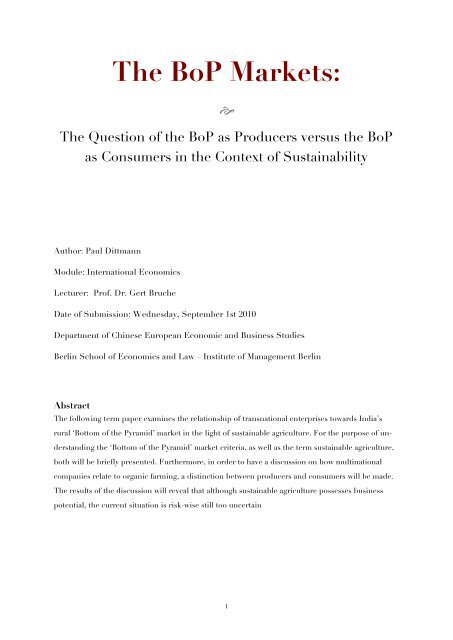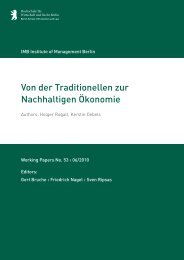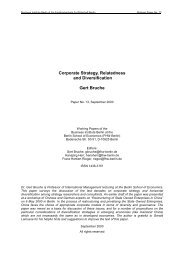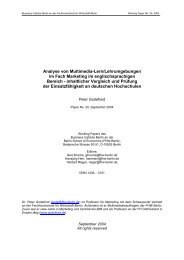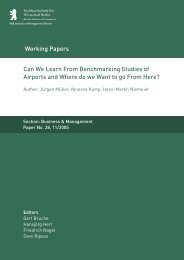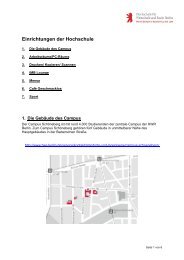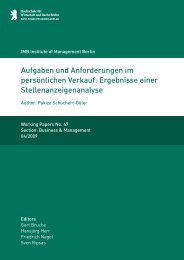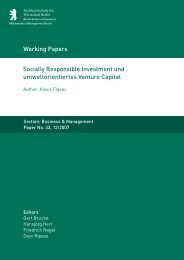The BoP Markets:
The BoP Markets:
The BoP Markets:
You also want an ePaper? Increase the reach of your titles
YUMPU automatically turns print PDFs into web optimized ePapers that Google loves.
<strong>The</strong> <strong>BoP</strong> <strong>Markets</strong>:<br />
e<br />
<strong>The</strong> Question of the <strong>BoP</strong> as Producers versus the <strong>BoP</strong><br />
as Consumers in the Context of Sustainability<br />
Author: Paul Dittmann<br />
Module: International Economics<br />
Lecturer: Prof. Dr. Gert Bruche<br />
Date of Submission: Wednesday, September 1st 2010<br />
Department of Chinese European Economic and Business Studies<br />
Berlin School of Economics and Law – Institute of Management Berlin<br />
Abstract<br />
<strong>The</strong> following term paper examines the relationship of transnational enterprises towards India’s<br />
rural ‘Bottom of the Pyramid’ market in the light of sustainable agriculture. For the purpose of un-<br />
derstanding the ‘Bottom of the Pyramid’ market criteria, as well as the term sustainable agriculture,<br />
both will be briefly presented. Furthermore, in order to have a discussion on how multinational<br />
companies relate to organic farming, a distinction between producers and consumers will be made.<br />
<strong>The</strong> results of the discussion will reveal that although sustainable agriculture possesses business<br />
potential, the current situation is risk-wise still too uncertain<br />
1
Table of Contents<br />
ABSTRACT 1<br />
TABLE OF CONTENTS 2<br />
LIST OF ABBREVIATIONS 2<br />
1. INTRODUCTION 3<br />
2. BOP MARKETS 3<br />
3. SUSTAINABLE DEVELOPMENT 4<br />
4. PRODUCER MARKET 5<br />
5. CONSUMER MARKET 6<br />
6. CONCLUSION 6<br />
REFERENCES 8<br />
List of Abbreviations<br />
Abbreviation Term<br />
<strong>BoP</strong> Bottom of the Pyramid<br />
ITC Indian Tobacco Company<br />
MNE Multinational Enterprise<br />
NGO Non-governmental Organisation<br />
PPP Purchasing Power Parity<br />
2
1. Introduction<br />
This term paper examines the ‘Bottom of the Pyramid’<br />
(<strong>BoP</strong>) markets in light of sustainable development from<br />
the perspective of multinational enterprises (MNEs).<br />
Since this topic is of a very broad nature, the author limits<br />
the discussion in its scope and scale to the region of rural<br />
India and to the industry of agricultural goods and ser-<br />
vices, as it is the <strong>BoP</strong> individuals’ primary source of<br />
spending (see Chapter 2 for details). Furthermore, as the<br />
<strong>BoP</strong> individuals can be producers or consumers, as well<br />
as both for MNEs the author discusses both phenomena<br />
separately.<br />
<strong>The</strong> research question, which this paper tries to answer, is<br />
the following: Are MNEs encouraging the usage of sus-<br />
tainable farming practices at the <strong>BoP</strong> and are MNEs<br />
offering goods and services which promote and improve<br />
sustainable farming? In order to answer this question the<br />
author of this paper first examines the <strong>BoP</strong> markets as a<br />
whole with a special focus on the characteristics of these<br />
markets. In the second part of his paper the author takes<br />
up the topic of sustainable development in the agricultur-<br />
al sector with a focus on the three pillars of ecological,<br />
socio-political and economic development. Afterwards<br />
India’s <strong>BoP</strong> producer and consumer market will be dis-<br />
cussed in the context of which MNEs use the <strong>BoP</strong> as<br />
producers for organic farming, as well as targets the <strong>BoP</strong><br />
as consumers for supplementary goods and services to<br />
organic farming. At last the author will conclude this term<br />
paper with presenting the reader with the findings of the<br />
discussion, as well as provide a recommendation to<br />
MNEs seeking business potential in India’s agricultural<br />
sector.<br />
2. <strong>BoP</strong> <strong>Markets</strong><br />
This section of the paper provides an overview over the<br />
various <strong>BoP</strong> markets and furthermore describes the<br />
unique characteristics of such markets.<br />
Regarding the <strong>BoP</strong> markets there is some dispute over the<br />
exact amount of people who fall under this category,<br />
which ranges in its estimation from 600 million to four<br />
billion people (Holtbruegge & Schuster, 2009, p. 1338).<br />
Furthermore is there also a dispute on the upper bound of<br />
the annual purchasing power parity (PPP) for a <strong>BoP</strong><br />
3<br />
individual. While Prahalad (2009) estimates the annual<br />
PPP to be limited to 750 US Dollars (p. 35), Hammond et<br />
al. (2007) estimate this amount to be around 3,000 US<br />
Dollars (p. 13).<br />
Concerning the potential of <strong>BoP</strong> markets for MNEs, a<br />
study from the year 2007 shows that the large <strong>BoP</strong> mar-<br />
kets in Africa, Asia, Latin-America and Eastern Europe<br />
combined have a total purchasing power of 5,000 billion<br />
US Dollars per year. Out of this annual purchasing pow-<br />
er, <strong>BoP</strong> individuals expend 58 per cent for food, 8.7 per<br />
cent for energy, 6.7 per cent for building materials, 3.6<br />
per cent for transportation, 3.2 per cent for health care,<br />
one per cent for communication and 18.8 per cent for<br />
other unallocated purposes. <strong>The</strong> biggest <strong>BoP</strong> market in<br />
this study is Asia with 83 per cent of the Asian population<br />
and 42 per cent of the overall purchasing power (Ham-<br />
mond et al., as cited in Holtbruegge & Schuster, 2009, p.<br />
1338).<br />
<strong>BoP</strong> markets are defined to have certain characteristics,<br />
which are unique towards other markets. <strong>The</strong>se charac-<br />
teristics reflect themselves in six distinguishable criteria,<br />
with the first criterion being the low purchasing power of<br />
the <strong>BoP</strong> markets. This criterion requires MNEs to be<br />
aware of high price sensitivity in the market, and that<br />
overall, the <strong>BoP</strong> does not purchase products at a frequent<br />
basis and if it does only in low quantities. This results in<br />
MNEs to implement a design-to-cost strategy, in which<br />
the development of a product is tailor-made to the <strong>BoP</strong><br />
purchasing constraints. <strong>The</strong> second criterion is the lack of<br />
information concerning the <strong>BoP</strong> markets. If an MNE<br />
wants to enter a <strong>BoP</strong> market it requires certain infor-<br />
mation on its size and structure. However this kind of<br />
information can be difficult to obtain as there is hardly<br />
any data available on the market itself. An answer to this<br />
problem can be potential partnerships with governments<br />
and non-governmental organizations (NGOs), which<br />
possess rare data on the size and structure of <strong>BoP</strong> mar-<br />
kets. <strong>The</strong> third criterion is the almost absolute absence of<br />
skills and knowledge in the <strong>BoP</strong> markets. <strong>The</strong> <strong>BoP</strong> indi-<br />
viduals regularly do not know what advantages certain<br />
products have and what needs are covered through the<br />
usage of certain goods and services. This has the effect<br />
that MNEs first have to conduct awareness training in the
<strong>BoP</strong> markets, in order to create the demand for certain<br />
products. <strong>The</strong> fourth criterion is the limited access to<br />
financial resources in the <strong>BoP</strong> markets. As the <strong>BoP</strong> indi-<br />
viduals rarely have the ability to receive loans from banks,<br />
more expansive products are not affordable. Although,<br />
some financial institutions have specialized themselves in<br />
lending out microloans to the <strong>BoP</strong>, its majority is still<br />
missing financing options for the more expensive prod-<br />
ucts. <strong>The</strong> fifth criterion is the precarious legal framework<br />
of the <strong>BoP</strong> markets. As there is a lack of protection to-<br />
wards intellectual property rights in these markets and<br />
furthermore an overall missing ability to sense right from<br />
wrong, the only opportunity MNEs have to safeguard<br />
their products is to integrate <strong>BoP</strong> individuals into social<br />
networks, which have the effect to pressure individuals to<br />
act in adherence with the whole network, as otherwise a<br />
misconduct would have a negative effect on both the<br />
individual and the network. <strong>The</strong> sixth and last criterion is<br />
the absence of proper infrastructures in the <strong>BoP</strong> markets.<br />
In most rural areas there is no connection to the public<br />
mains supply and there is a prevailing non-existence of<br />
normal communication channels. This has the effect that<br />
MNEs’ development and marketing of <strong>BoP</strong> products<br />
cannot be done in the usual manner. <strong>The</strong> missing infra-<br />
structure also influences the logistics and distribution of<br />
products, by causing difficulties for the MNEs of keeping<br />
product shipment costs low, which would otherwise result<br />
in higher output prices. A solution for the missing infra-<br />
structure is to produce the goods and services locally with<br />
having small local distribution networks (Holtbruegge &<br />
Schuster, 2009, pp. 1338-1340).<br />
3. Sustainable Development<br />
This section of the paper introduces the theoretical as-<br />
pects of sustainable development and explains its dimen-<br />
sions in the case of sustainable agriculture.<br />
Sustainable development is based on the three pillars<br />
deriving from the interaction of economic, sociopolitical<br />
and environmental sustainable development. This rela-<br />
tionship was first brought up by the United Nations<br />
‘Brundtland Commission’, in the year 1987 and was<br />
further developed at the United Nations ‘2005 World<br />
Summit’ (Bayley & Strange, 2008, pp. 24-28).<br />
4<br />
Concerning developing countries’ agricultural sectors<br />
one has to differentiate between various methods of farm-<br />
ing techniques, such as traditional production systems,<br />
conventional modern agriculture and sustainable agricul-<br />
ture. In the case of sustainable agriculture, the ecological<br />
component, as one of the three pillars, has to be made<br />
sustainable in the sense that there is a rethinking in how<br />
to use natural capital. As agriculture is a significant con-<br />
tributor to global climate change, greenhouse gas emis-<br />
sions can be lowered through the usage of non-artificial<br />
fertilizers. Moreover, by using organic fertilizer the water<br />
quality used for irrigation and consumption is not im-<br />
paired and the water availability is improved as the top-<br />
soil, richer in organic matter, can retain and store water<br />
more efficiently. Furthermore an appropriate usage of the<br />
farming land is vital in order to avoid erosion, flooding<br />
and landslides. An improved usage of land can lead to<br />
higher productivity, conservation of nutritious soil and<br />
the preservation of rural jobs. Another sustainable change<br />
is the mixing of crops which increases the diversity of<br />
crops produced on the one hand and on the other hand<br />
raises the diversity of insects, animals and plants in and<br />
around the fields, which can act as a substitute for haz-<br />
ardous pesticides (GTZ Sustainet, 2006, pp. 3-4).<br />
Another component of agricultural sustainability is the<br />
economic pillar. It requires an equal emphasis given to<br />
both exports and local orientation, as if there was merely<br />
a focus on exports, local food security would not be guar-<br />
anteed. Employment is another vital factor as farming is<br />
the main source of employment and income in the rural<br />
areas. Through small-scale and labor-intensive farming,<br />
employment rates in rural areas can be kept relatively<br />
steady. <strong>The</strong> higher costs, which are inevitably incurred<br />
through this kind of farming, could be substituted by the<br />
quickly rising demand which organic products currently<br />
enjoy (GTZ Sustainet, 2006, pp. 4-5).<br />
<strong>The</strong> third and last component of sustainable agriculture is<br />
the sociopolitical pillar. One of its aims is to reduce pov-<br />
erty through the means of organic farming, as it targets<br />
the poor to gain benefits from sustainable agriculture and<br />
not the intermediaries and end-consumers. However, this<br />
requires the technology which is used for organic farming<br />
to be in conformity with the local social customs, norms
and traditions, in order for the local farmers to trust and<br />
believe in those technologies. This would furthermore<br />
have the benefit that indigenous knowledge, which fea-<br />
tures traditional knowhow and local innovation, can<br />
potentially complement the technologies, which are<br />
brought in from the outside. Another factor is that sus-<br />
tainable agriculture fosters participation of both genders<br />
and targets especially those groups with a low PPP. This<br />
participation results in the sharing of burdens and bene-<br />
fits more equitable between men and women, as well as<br />
that the rural poor can organize themselves and promote<br />
a dialogue with other members of society. At last, the<br />
farmers also benefit through sustainable agriculture as<br />
they can become more self-reliant concerning their diet,<br />
due to the fact that their produce offers a wider range of<br />
goods throughout the year and therefore is to a large<br />
extent self-supporting (GTZ Sustainet, 2006, pp. 5-6).<br />
4. Producer Market<br />
This chapter of the paper gives a brief overview over the<br />
current level of organic farming in India and furthermore<br />
examines which MNEs use India’s rural <strong>BoP</strong> as produc-<br />
ers in the context of promoting sustainable farming.<br />
According to Narayanan (2005) India’s organic farming<br />
has been present since the early 1980s. Three different<br />
interest groups pursued this method of farming. <strong>The</strong> first<br />
group consisted out of “urban educated technocrats” (p.<br />
45), which did not last long, whereas the second group<br />
was made out of educated farmers, who through scientific<br />
knowledge had acquired the knowhow for sustainable<br />
farming. Farmers who tried to master organic farming by<br />
trial and error formed the third and last group. He fur-<br />
thermore states that out of those groups only the ones<br />
that had sufficient natural resources on their farmland<br />
available succeeded in organic farming without affecting<br />
the yield and their income. However, compared to other<br />
countries, India’s organic farming sector is still in the<br />
fledging stages, as the area used for sustainable farming<br />
is tiny with 41,000 hectares compared to Australia’s<br />
massive 10.5 million hectares used for organic farming.<br />
<strong>The</strong> majority of India’s organic produce is exported (85<br />
per cent in 2002), with only a small percentage remaining<br />
in the country for local consumption (Narayanan, 2005,<br />
pp. 45-46), which has a customer base not larger than<br />
5<br />
three million people (GTZ Sustainet, 2006, p. 21). Most<br />
organic farming initiatives are spearheaded by various<br />
NGOs such as the ‘Himshikha Development Project’,<br />
which observed that with introducing organic farming to<br />
rural farms in India, the farmers have increased their acre<br />
yield by 50 per cent and that overall, higher prices are<br />
offered for their produce. Furthermore, the NGO states<br />
that through organic farming the cost of production for<br />
the farmers has dropped significantly as they use cheaper<br />
and even free bio-fertilizers such as compost, cattle dung<br />
and organic sprays on their fields. However, it has to be<br />
mentioned that the NGO has also agreed to buy the farm-<br />
ers’ produce for at least three years and that a premium is<br />
paid when irrigation facilities are installed on the fields<br />
(HDP, n.d., pp. 7-8).<br />
Coming to the case of MNEs in India’s agricultural sector<br />
that foster the <strong>BoP</strong> as producers, Karnani (2007) can only<br />
identify one MNE who is currently pursuing this kind of<br />
undertaking (p. 93). <strong>The</strong> Indian Tobacco Company (ITC),<br />
India’s second largest exporter for agricultural goods,<br />
introduced a system in the year 2000, which enables<br />
farmers to sell their produce directly to ITC instead of<br />
having to sell it to a middleman at state-sanctioned<br />
wholesale markets. At these markets the farmers used to<br />
have the dilemma that they had to transport their produce<br />
over long distances, as these markets are functioning as<br />
hub for rural areas. At these markets the farmers were<br />
offered prices for their produce on an individual basis and<br />
had often no bargaining power, due to the fact that they<br />
had no idea what the prevailing market prices were. ITC<br />
responded to that dilemma with introducing an IT sys-<br />
tem, called ‘e-choupal’ , which provides the farmers with<br />
the ability of receiving real-time market prices of their<br />
produce, forums in which they receive advice in farming<br />
techniques and other relevant information relevant to<br />
farming, as well as an alternative selling channel in which<br />
they can sell their produce straight to ITC. For the latter<br />
purpose, ITC established procurement centres in proximi-<br />
ty of these ‘e-choupal’ terminals, in order to minimize the<br />
transportation distances for the farmers (Vachani &<br />
Craig-Smith, 2008, pp. 59-62). Recently ITC has also<br />
started to introduce special mobile phones in the rural<br />
areas in order to allow farmers to communicate with one<br />
another on market information concerning their produce
(Business Today, 2009, p. 81). However the ITC’s system<br />
does not support organic products, yet. Although it covers<br />
the procurement of soya beans, coffee, wheat, rice, pulses<br />
and shrimp (Vachani & Craig-Smith, 2008, p. 60), some<br />
of which are produced by organic farming (GTZ Sus-<br />
tainet, 2006, p. 22), the majority of ITC’s produce is still<br />
harvested from conventional farms.<br />
ITC’s lack of interest in procuring organic produce may<br />
be the result of certain difficulties, which India’s organic<br />
farming sector currently must cope with. As for one, one<br />
of the biggest challenges is the creation of bio-fertilizers<br />
and organic manures. Although cheap or even free of<br />
charge in its production, the knowhow for creating those<br />
supporting agents is still absent in most rural areas. This<br />
has the effect that by measuring the input costs for creat-<br />
ing organic fertilizers; it is often cheaper to acquire chem-<br />
ical fertilizers. Furthermore, many commercially available<br />
organic manures lack the required quality standards,<br />
which means that soil quality suffers tremendously. An-<br />
other difficulty is that most seeds in circulation for farm-<br />
ing purposes are hybrid seeds, which are designed to be<br />
most efficient with chemical fertilizers and pesticides. <strong>The</strong><br />
remaining difficulties lie with the Indian government and<br />
the lack of supporting infrastructure for sustainable agri-<br />
culture. Up to the year 2002, there were only four agen-<br />
cies for accreditation purposes and all of them charged a<br />
yearly fee for each farm that had to be certified as an<br />
organic goods producer. Furthermore, until this point<br />
there is no proper promotion for organic goods in India<br />
through agricultural policies (Narayanan, 2005, pp. 57-<br />
62).<br />
5. Consumer Market<br />
This section of the paper examines which MNEs offer<br />
goods and services to India’s rural <strong>BoP</strong> that compliment<br />
and support organic farming.<br />
<strong>The</strong>re are two MNEs that offer large quantities of prod-<br />
ucts for consumption to India’s rural <strong>BoP</strong>. One of them is<br />
again ITC. After ITC introduced its e-choupal system it<br />
went on to create ITC Mini-Malls which are small shop-<br />
ping malls located near ITC’s produce procurement cen-<br />
tres. <strong>The</strong>se malls offer a variety of products, including<br />
packaged consumer goods, white goods, fuel and agricul-<br />
tural inputs, as well as various services, such as insurance<br />
6<br />
and banking. <strong>The</strong> e-choupal system in addition also offers<br />
the farmers the option of ordering products from the<br />
malls, which then later will be delivered by another farmer<br />
visiting the mall. Concerning the prices of these products,<br />
some of them are 30-40 per cent less expensive than<br />
comparable products in large cities (Vachani & Craig-<br />
Smith, 2008, pp. 63-64).<br />
<strong>The</strong> other MNE offering such goods and services is Hin-<br />
dustan Lever through its project Shakti by Unilever. <strong>The</strong><br />
company hires women who sell Unilever products in their<br />
villages. One Shakti entrepreneur covers around 4,000<br />
potential customers in three to eight villages. <strong>The</strong>se en-<br />
trepreneurs invest a total of 220-330 US Dollars in goods<br />
through microloans and then resell those items in the<br />
villages with making a monthly profit around 15-22 US<br />
Dollars. Items being sold include packaged consumer<br />
goods, health products and agricultural inputs, etc.<br />
Through an IT system similar to the e-choupal, the villag-<br />
ers can also inform themselves, amongst other things, on<br />
fertilizer usage as well as pest control (Unilever, 2005, pp.<br />
2-3). Furthermore Unilever, together with the Indian<br />
government, is funding irrigation projects in order to<br />
increase water supply for farms producing tea. This how-<br />
ever can be regarded as self-interest, as Unilever, with its<br />
brand Lipton, produces around 12 per cent of the world-<br />
wide volume for black tea (Unilever, 2009, pp. 19-20).<br />
Both companies offer agricultural inputs in the form of<br />
goods and services to the farmers. However, it remains<br />
unknown as to how specific some of these inputs are<br />
towards organic farming. It can be speculated that agri-<br />
cultural inputs are merely a by-product of offering pack-<br />
aged consumer goods to the farmers as they are products,<br />
which in their production cost are rather inexpensive.<br />
6. Conclusion<br />
<strong>The</strong> author of this term paper concludes that with regards<br />
to the case of sustainable agriculture in India, the MNEs<br />
have until today not tapped the business potentials of this<br />
sector, as he expects that the risks of moving into this<br />
market are still too uncertain in India.<br />
In the case of the <strong>BoP</strong> as a consumer for products being<br />
supplementary to sustainable agriculture, is it unknown<br />
which kinds of agricultural goods and services are being
offered to the farmers. It can however be speculated that<br />
the agricultural inputs that are being offered are a matter<br />
of chemical fertilizers and pesticides. Moreover, it can<br />
also be speculated that services containing knowhow and<br />
recommendations for using farmland more effectively are<br />
also on the basis of non-organic agricultural input, as the<br />
majority of the farmers still use this kind of input in order<br />
to enhance their harvest.<br />
In the case of the <strong>BoP</strong> as a producer for MNEs in the<br />
organic farming sector, it can be said that until today no<br />
MNE has made any investments directly targeting sus-<br />
tainable agriculture. Although ITC has started a program<br />
which fosters the farmers as producers, directly produc-<br />
ing for the company, the company has refrained itself<br />
from directly promoting organic farming. This however is<br />
connected to the difficulties that this sector still experi-<br />
ences, which in return are largely matters that have to be<br />
addressed on a the state level. Yet, this might be subject to<br />
change in the near future as there are currently many<br />
7<br />
NGOs, which are carrying out preparatory work in this<br />
sector.<br />
<strong>The</strong> author recommends to the industry that although the<br />
current situation concerning organic farming seems dire<br />
in India, the market for using the <strong>BoP</strong>, both as producers<br />
and consumers, could be a promising business potential,<br />
due to the fact that organic farming gains in popularity<br />
and it is more effective in the long-run than other meth-<br />
ods of farming. However, in order for this to be viable it<br />
requires the government of India to take an explicit posi-<br />
tion towards promoting the idea of sustainable agricul-<br />
ture, even though it may in the short-run abut with the<br />
profitability of conventional farming. Yet, seen from a<br />
long-term perspective the shift towards the strong promo-<br />
tion of organic farming could lead to higher profitability<br />
for MNEs conducting business in the agricultural sector<br />
and as well alleviate poverty in India’s rural <strong>BoP</strong>.
References<br />
Bayley, A., & Strange, T. (2008). Sustainable development – linking economy, society, environment. Paris: OECD Publica-<br />
tions.<br />
Business Today. (2009). E-choupal version 3.0. Retrieved May 23, 2010, from EBSCO database.<br />
GTZ Sustainet. (2006). Sustainable agriculture – a pathway out of poverty for India’s rural poor. Eschborn: GEZ Publica-<br />
tions.<br />
Hammond, A., Kramer, W., Katz, R., Tran, J. & Walker, C. (2007). <strong>The</strong> next 4 billion – market size and business strategy at<br />
the base of the pyramid. Retrieved July 19, 2010, from http://rru.worldbank.org/thenext4billion.<br />
HDP. (n.d.). Himshikha development project: for a sustainable development and future together. Retrieved August 4, 2010,<br />
from http://www.unep.org /climateneutral/Portals/0/HDP_Presentation_12_0_njDKo_4O8VL.pdf<br />
Holtbruegge, D., & Schuster, T. (2009). Bottom of the pyramid – Märkte [Bottom of the pyramid – markets]. Wisu, 10(9),<br />
1337-1341.<br />
Karanani, A. (2007). <strong>The</strong> mirage of marketing to the bottom of the pyramid. Retrieved May 23, 2010, from EBSCO database.<br />
Narayanan, S. (2005). Organic farming in India: relevance, problems and constraints. Retrieved August 4, 2010, from<br />
http://www.nabard.org /fileupload/DataBank/OccasionalPapers/OC%2038.pdf<br />
Prahalad, C. (2009). Fortune at the bottom of the pyramid – eradication poverty through profits. Upper Saddle River: Whar-<br />
ton School Publishing.<br />
Unilever. (2005). Project shakti: creating rural entrepreneurs in India. Retrieved August 2, 2010, from<br />
http://www.unilever.com/images /es_Project_Shakti_tcm13-13297.pdf<br />
Unilever. (2009). Sustainable development overview: 2009. Retrieved August 2, 2010, from http://www.unilever.com/images<br />
/sd_UnileverSDReport170310_amended_tcm13-212972.pdf<br />
Vachani, S., & Craig-Smith, N. (2008). Socially responsible distribution: distribution strategies for reaching the bottom of the<br />
pyramid. Retrieved May 23, 2010, from EBSCO database<br />
8


